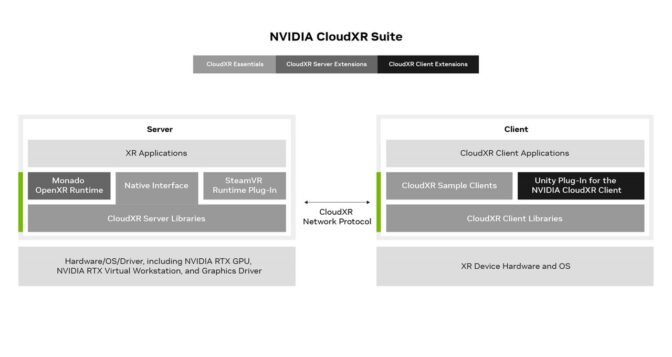Organizations across industries are using extended reality (XR) to redesign workflows and boost productivity, whether for immersive training or collaborative design reviews.
With the growing use of all-in-one (AIO) headsets, more teams have adopted and integrated XR. While easing XR use, AIO headsets have modest compute and rendering power that can limit the graphics quality of streaming experiences.
NVIDIA is enabling more enterprises and developers to adopt high-quality XR with its CloudXR Suite. Built to greatly simplify streaming, CloudXR enables anyone with an AIO headset or mobile XR device to experience high-fidelity, immersive environments from any location.
CloudXR Suite combines the power of NVIDIA RTX GPUs and NVIDIA RTX Virtual Workstation (vWS) software to stream high-fidelity XR applications to Android and iOS devices. By dynamically adjusting to network conditions, CloudXR maximizes image quality and frame rates to power next-level, wireless augmented-reality and virtual-reality experiences.
With CloudXR, enterprises can gain the flexibility to effectively orchestrate and scale XR workloads, and developers can use the advanced platform to create custom XR products for their users. The suite offers high-quality streaming across both public and private networks.
Ericsson and VMware are among the first companies to use CloudXR.
Taking XR Workflows to the Next Level
CloudXR Suite offers performance that’s comparable to tethered VR experiences.
It comprises three components, including several updates:
- CloudXR Essentials, the suite’s underlying streaming layer, brings new improvements such as 5G L4S optimizations, QoS algorithms and enhanced logging tools. Essentials also includes the SteamVR plug-in, along with sample clients and a new server-side application programming interface.
- CloudXR Server Extensions improves server-side interfaces with a source-code addition to the Monado OpenXR runtime. The new CloudXR Server API contained in CloudXR Essentials and the OpenXR API represent the gateway to scaling XR distribution for orchestration partners.
- CloudXR Client Extensions include as a first offering a CloudXR plug-in built for the Unity Editor. This lets developers build custom CloudXR client applications using already-familiar Unity development tools. Plus, Unity app developers can more easily build applications with branded custom interfaces and lobbies before connecting to their CloudXR streaming server using the plug-in.
Teams can tap into the power of NVIDIA RTX GPUs to achieve ultimate graphics performance on mobile devices. Enterprises can scale to data center and edge networks, and stream to concurrent users with NVIDIA RTX vWS software.
In addition, users can stream stunning XR content from any OpenVR or OpenXR application at the edge using high-bandwidth, low-latency 5G signals.
Partners Experience Enterprise-Grade XR Streaming
Organizations across industries use XR streaming to advance their workflows.
To provide optimal streaming performance, NVIDIA is working with leading companies like Ericsson to implement low-latency, low-loss scalable throughput (L4S) in NVIDIA CloudXR. L4S helps reduce lag in interactive, cloud-based video streaming, so CloudXR users will be able to experience photorealistic XR environments on high-bandwidth, low-latency networks.
“At Ericsson, we believe innovations like L4S are fundamental building blocks to enable latency-critical applications,” said Sibel Tombaz, head of product line for 5G Radio Access Network at Ericsson. “As a key part of Ericsson’s Time-Critical Communication capabilities, L4S will significantly improve user experience for use-cases like cloud gaming, and its great news that NVIDIA is making L4S a production element of CloudXR. We’re excited to be working with NVIDIA to further enhance the XR experience for enterprises, developers and consumers.
More professionals can elevate XR streaming from the cloud with VMware Workspace ONE XR Hub, which includes an integration of CloudXR.
Workspace ONE XR Hub enhances user experiences with VR headsets through advanced authentication and customization options. Combined with the streaming capabilities of CloudXR, Workspace ONE XR Hub allows teams across industries to quickly, securely access complex immersive environments using AIO headsets.
“With this new integration, access to high-fidelity immersive experiences is even easier because streaming lets users tap into the power of RTX GPUs from anywhere,” said Matt Coppinger, director of product management for end-user computing at VMware. “Workspace ONE XR Hub and CloudXR will allow our customers to stream rich XR content, and more teams can boost productivity and integrate realistic, virtual experiences into their workflows.”
Availability
CloudXR Suite will be available to download soon, so users can stream a wide range of XR applications over the network without worrying about demanding graphics requirements.
For example, independent software vendors (ISVs) can create a single, high-quality version of their application that’s built to take advantage of powerful GPUs. And with CloudXR streaming, ISVs can target users with mobile XR devices.
Mobile-device manufacturers can also offer their ISV partners and end users access to high-performance GPU acceleration for unparalleled graphics experiences.
In addition, cloud service providers, orchestrators and system integrators can extend their GPU services with interactive graphics to support next-generation XR applications.
Learn more about NVIDIA CloudXR Suite.

